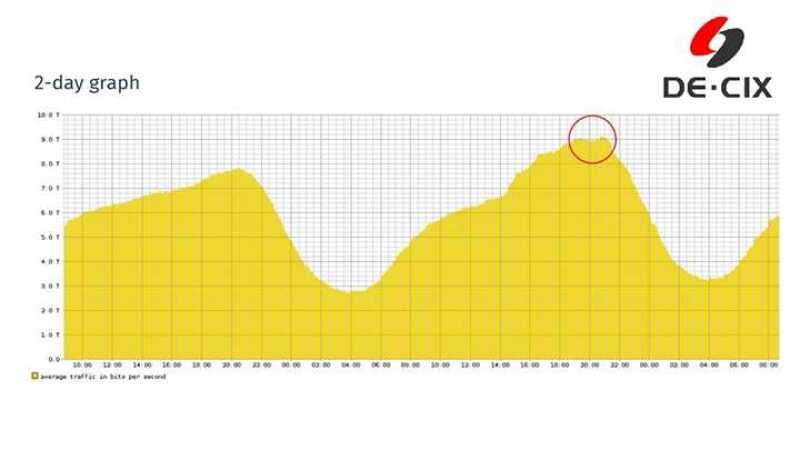Since the start of 2020, almost two billion people around the world have been told that they must stay indoors, work from home and limit all social contact for the foreseeable future.
The Covid-19 lockdown may still be in its early days for Europe, the US and countries in the southern hemisphere, but already data is emerging that suggests its impact will reach far beyond health.
Over the month of March, the world’s largest internet exchange DE-CIX Frankfurt, confirmed several new traffic records.
On the evening of 10 March, the exchange recorded a new all-time traffic peak of more than 9.1 Terabits per second – a feat originally expected to happen around “the end of 2020”.
It was the highest jump in traffic the exchange has ever recorded, up 12% from the previous 8 Tbps record logged in December. Between March 11 and 18, overall traffic increased 10% and there was a 50% increase in video conferencing, with a 25% increase in online and cloud gaming traffic. Similar spikes were observed in social media and VPN demand.
Around the world, service providers are backing DE-CIX Frankfurt’s observations. To cherry pick a few: Verizon reported a 34% increase in VPN traffic between March 10 and 17, while gaming traffic increased 75%; Vodafone has seen a 50% rise in internet use in some European countries; and AT&T has seen a 40% rise in mobile volumes and a 100% increase in Wifi calls. Mobile operators around the world have also reported a sharp increase in Wifi use.
“We are seeing the increase in capacities, especially with the major global internet and content providers. In some cases, the capacities have been more than doubled. Especially in international data hubs such as New York, Madrid and Frankfurt, the demand for more capacities at the DE-CIX Internet Exchanges is high. Here, too, we are seeing new record levels of data traffic at peak times,” says Ivo Ivanov, CEO DE-CIX International.
“In times when people have to practice social distancing and perhaps self-isolate… the exchange of data must run smoothly. Here we see it as our maxim to guarantee our customers – and thus internet users worldwide – a trouble-free, secure, and reliable Internet,” Ivanov adds.

Influencing behaviour
Despite what the figures suggest, not everybody is watching Netflix. There is an insatiable thirst for information right now and people are turning to the internet for advice, just as much as they are entertainment.
Then there is the need to continue with work and school.
Evan Dixon, MD of Viasat Europe, says: “The sheer volume of those working and schooling from home will almost certainly transform the way broadband is used. What we are likely to see is an increase in the number of ways people are connected – whether over a fibre connection, community Wifi, 4G, or even satellite broadband.
“We may be witnessing an unprecedented shift in behaviour, but networks have been built to be able to deal with this change,” he adds.
For Angelique Medina, director of product marketing at ThousandEyes, the trend is likely to reach much further.
“It’s not just workers that are now online, our whole lives are online. Churches are live streaming services, telemedicine is taking off, shopping patterns have changed, whether it’s groceries and necessities or otherwise. [Covid-19] really has created this interesting shift to everything being virtual and digital,” she says.
“How will that play out? There will be some rebalancing but I do think that there is actually going to be more working and interaction that is going to be done online going forwards as a result of this, than we have ever seen before. Maybe usage will come down a little bit, but I think [service providers and collaboration applications] realise that they are going to be used much more heavily going forwards,” Medina continues.
Responding to change
As well as providing a real time map of “internet health”, ThousandEyes works with the likes of Microsoft, Slack, ebay, Paypal, Volvo and others, to provide insight on network performance and dependencies. In turn, these clients feedback their observations.
With such a vantage point on the industry, Medina says it isn’t just the customers that are changing. It is likely that even after things normalise many people will continue to work remotely, and network operators and service providers will need to adapt in response.
“From an ISP standpoint they need to think about how to service access networks and how to scale those out over time. At the same time, it may be that the enterprise networks and services become less important and that consumer-grade access networks are now prioritised more in line with enterprise networks because so many people are using them to work from home.
“It may be that the way different customer types are prioritised will change and that may hold going forward. That may not ever go back to the way it was,” she explains.
The future of billing
In response to the demand for information, many service providers have suspended data caps and zero-rated certain websites in a bid to help everybody access what they need. The prioritisation of some services over others is an instinctive reaction at a challenging time, but it could create problems down the line.
Mann says: “Telecom operators need to carefully model the impact of easing tariff restrictions to ensure they have sufficient capacity to manage increased usage. Limiting caps is a move that will resonate well with many customers, whilst also earing welcome goodwill for operators, but if the networks are unable to cope with demand it could do more harm than good.”
Add the so called zero price effect to the mix and the problems suddenly get much worse. Because even if the network can cope with the added capacity, how do you reinstate a charge for something that has so recently been given away for free?
“I don’t think the industry knows the answer to that, but I do think it is very much a question mark,” says Mike O’Malley head of carrier services at Radware.
O’Malley predicts that our changing attitude towards the internet will likely extend to our attitudes around security and that, even if consumers no longer wish to pay for a connection, their growing appetite for security solutions – driven by such developments as hacker groups offering ransom discounts – will likely plug any void in revenues.
“That could create a great revenue stream for service providers because previously [security] was maybe the fourth or fifth priority on people’s lists, but now it’ll be first or second” he adds.
However, the real game changer for O’Malley is the future of face-to-face business culture.
He says: “Spanish [business] culture for example is very much face-to-face, but now they are being forced to change the norms of their society and we are doing all our meetings via Webex.
“The question out of this is if that trend will change people’s usage patterns and how they interact with these devices? At what point will this get baked in as the normal operating procedure, vs what ability will the service provider have to actually charge additionally for that? Or will they have to find new services to charge for?”
Life on pause
Covid-19 is changing the world on an hour to hour basis; that it is also changing how people access and use the internet comes as no surprise. But there is a strange irony in how 2020 is playing out.
Before the pandemic, this year was tipped to be one of the most important in recent times with the big behavioural change expected to be human/machine interaction, facilitated by widespread 5G coverage. It would have brought huge gains for healthcare, finance and other areas of business and life.
With life on pause until further notice, what happens now?
Ironically, the use case is still there – it just takes a different form. Instead of 5G being a springboard for human/machine interaction, it is likely going to be the capacity patch that keeps the world connected. At least for now.
Postponed spectrum auctions will need to be completed in order to keep business and society ticking over in the coming months and, once fully back online, China’s manufacturing sector will be expected sto catch up with demand for 5G devices and components.
What will the world will look like at this point is anybody’s guess but when it comes to human behaviour in the face of crisis, Wifi is likely to remain just as important as loo roll.





